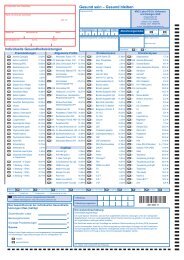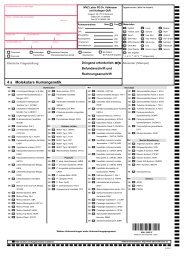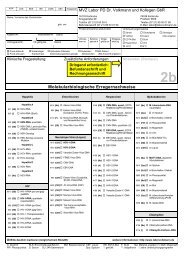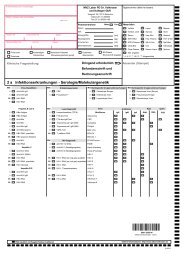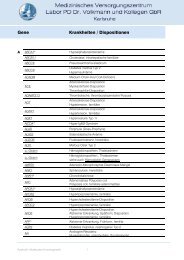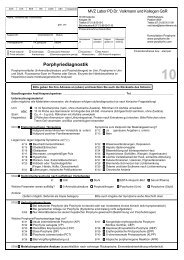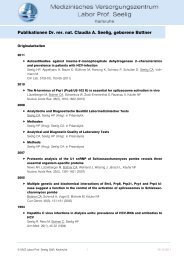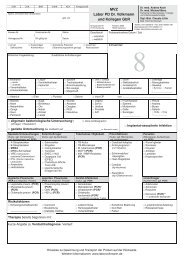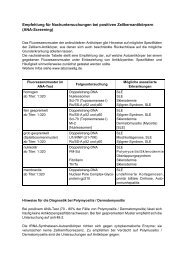ORIGINAL ARTICLE - MVZ Labor PD Dr. Volkmann und Kollegen
ORIGINAL ARTICLE - MVZ Labor PD Dr. Volkmann und Kollegen
ORIGINAL ARTICLE - MVZ Labor PD Dr. Volkmann und Kollegen
You also want an ePaper? Increase the reach of your titles
YUMPU automatically turns print PDFs into web optimized ePapers that Google loves.
spotting, resulting in four lanes containing 4, 8, 16 or<br />
32 ng IM<strong>PD</strong>H2 per strip. Membranes were blocked and<br />
processed as described above. Human and rabbit sera to<br />
be tested were diluted 1:100 in blocking buffer.<br />
Radioimmunoprecipitation assay (RIPA)<br />
For production of radiolabelled IM<strong>PD</strong>H2-tracer, the<br />
DNA sequence encoding amino acids 1 - 514 of human<br />
IM<strong>PD</strong>H2 was cloned into a pCITE4a vector (Novagen).<br />
In vitro transcription/translation (ivTT) was performed<br />
using a T7 promoter controlled coupled transcription/<br />
translation system based on rabbit reticulocyte lysate<br />
(Promega, Heidelberg, Germany) according to the manufacturer’s<br />
instructions. Briefly, 25 µL rabbit reticulocyte<br />
lysate, 2 µL reaction buffer, 1 µL amino acid mixture<br />
(without methionine), 1 µL T7 polymerase, 3.5 µL<br />
L- 35 S-methionine (PerkinElmer), 1 µL RNasin (40 U;<br />
Lonza, Verviers, Belgium) and 1 µg template DNA<br />
were pipetted into a nuclease free 1.5 mL reaction tube.<br />
Nuclease free water was added to a final volume of<br />
50 µL. After 90 minutes incubation at 30 °C, unincorporated<br />
35 S-methionine was removed on a Sephadex G-<br />
50 MicroSpin column (GE Healthcare). Aliquots were<br />
stored at -80 °C until used. The percentage of 35 S-methionine<br />
incorporated into the protein was calculated after<br />
liquid scintillation counting. Mean incorporation rates<br />
were 9.5 % (SD 2.5 %). The quality of the 35 S-methionine-IM<strong>PD</strong>H2<br />
was checked on SDS-PAGE (12.5 %,<br />
200 V), sample preparation and autoradiography was<br />
performed as described above.<br />
For antibody screening, 35 S-methionine labelled IM<strong>PD</strong>-<br />
H2 (tracer) was diluted in dilution buffer (20 mM Tris-<br />
HCl, pH 7.4, 150 mM NaCl, 0.15 % Tween-20, 100000<br />
KIE Aprotinin [Bayer, Leverkusen, Germany], 10 mM<br />
benzamidine, 0.1 % BSA) to an activity of 40000 cpm<br />
in 50 µL. Duplicates of patient and control sera (5 µL)<br />
were pipetted into the wells of a 96-well microtiter<br />
plate. 50 µL tracer were added to each well. After incubation<br />
for 3 hours at 4 °C on a plate shaker, 20 µL recombinant<br />
protein A bo<strong>und</strong> to fractogel (Merck, Darmstadt,<br />
Germany) were added (4 °C, 60 minutes). The reaction<br />
mixes were transferred to a 0.65 µm Durapore<br />
96-well filter plate (Millipore, Schwalbach, Germany).<br />
Unbo<strong>und</strong> antigen was removed by vacuum filtration and<br />
washing the filter plates 30 times with 100 µL RIP2<br />
buffer (20 mM Tris-HCl, pH 7.4, 150 mM NaCl,<br />
0.05 % Tween-20). After drying the plates overnight,<br />
20 µL liquid scintillation mix MicroScintO (PerkinElmer)<br />
were added to each well and the plates were<br />
counted using a Topcount NXT 96-well liquid scintillation<br />
counter (PerkinElmer).<br />
All assays were performed in duplicate. Five negative<br />
controls (healthy blood donors) were used to calculate<br />
the antibody concentrations (antibody ratio, ABR) according<br />
to the following formula: Antibody ratio (ABR)<br />
= (cpm (sample)/[mean cpm (negative controls) + 3.041<br />
SD (negative controls)]) x 10 (28). Sera positive for<br />
anti-IM<strong>PD</strong>H2 were retested with a homologous RIP assay,<br />
used for determination of antibodies against ste-<br />
H. P. SEELIG et al.<br />
756<br />
roid-21-hydroxylase to exclude a possible non-specific<br />
binding of the tracer.<br />
Statistical methods<br />
Receiver operating characteristic (ROC) curve analysis<br />
was conducted to determine the cut-off range between<br />
sera regarded as positive or negative for anti-IM<strong>PD</strong>H2.<br />
Each of the patient groups was compared with the control<br />
group of healthy blood donors. The specificity was<br />
regarded to be 98 %. The area <strong>und</strong>er the ROC curve<br />
(AUC) with 95 % confidence interval (CI) was calculated<br />
from the AUC, SE, CI according to Hanley (29).<br />
RESULTS<br />
Different immunofluorescence patterns evoked by<br />
patient serum<br />
The serum of the index patient screened on in house<br />
cultivated HEp-2 cells exhibited an intense staining of<br />
distinct granular particles diffusely dispersed within the<br />
cytoplasm (Figure 1, a, b). In many cells the granules<br />
appeared as condensed globular-shaped aggregates<br />
reaching numbers from one per cell up to more than a<br />
dozen (antibody titer 1: 1280). Only a very weak granular<br />
cytoplasmic fluorescence could be detected in five<br />
different commercial HEp-2 cell preparations (Orgentec,<br />
Menarini, Generic Assays, AESKU, AID), indicating<br />
that these cell preparations actually are not suitable<br />
for the identification of anti-IM<strong>PD</strong>H2 in human sera.<br />
A rather different immunofluorescence pattern, however,<br />
was obtained when the patient’s serum was reacted<br />
with two other commercial HEp-2 cell preparations<br />
(Inova Diagnostics, Euroimmun). Instead of a granular<br />
staining within the cytoplasm, one to three thin, smooth<br />
fluorescent filaments and/or one to three small plain<br />
rings with central apertures (Figure 1c, 1d) were seen.<br />
This uncommon fluorescence pattern was only recently<br />
described as “rods and rings” pattern in the context of<br />
proficiency tests for antinuclear antibodies (18).<br />
Possible antibody specificities associated with this pattern,<br />
however, were not identified.<br />
Subsequently, sera of four additional patients with this<br />
pattern of reactivity (granular within the cytoplasm on<br />
in house and “rods and rings” on the commercial HEp-2<br />
cell preparations (Euroimmun, Inova Diagnostics)) were<br />
fo<strong>und</strong>. Examination of the clinical data revealed that all<br />
four patients had past or ongoing HCV infections,<br />
which prompted the exploration of the prevalence of<br />
these antibodies in HCV-RNA positive patients.<br />
To examine whether the two different fluorescence patterns<br />
evoked by the same serum depended on variations<br />
in culture conditions or cell fixation, HEp-2 cells cultivated<br />
between 16 and 60 hours and thereafter treated<br />
with various fixatives as described above, were reacted<br />
with the patient’s serum. However, neither culture time<br />
nor kind of fixative could be linked to a possible transition<br />
of the two contrasting staining patterns. There was<br />
Clin. Lab. 9+10/2011



